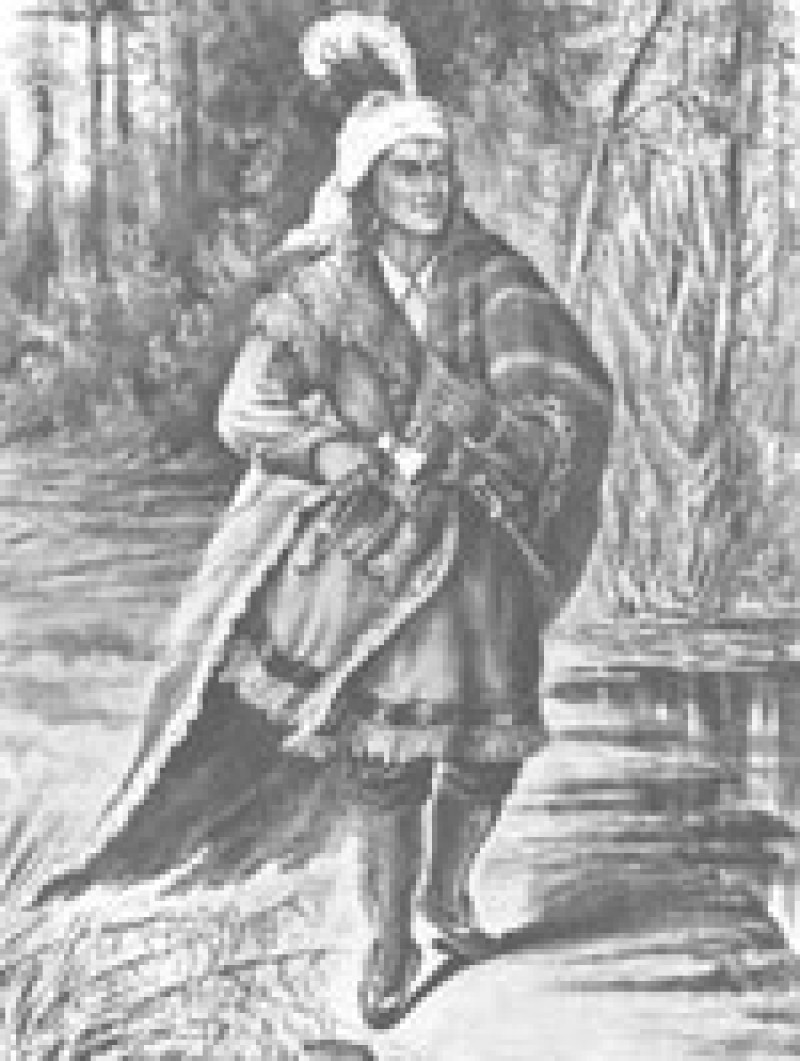Tecumseh (c. 1768 - Oct. 5, 1813)
Tecumseh was handsome, well proportioned and dignified. After 1805 he dressed mostly in traditional American Indian clothing. Astute and ambitious, he earned a reputation for temperance, generosity and humanity and was a warm and convivial companion.
Tecumseh, Shawnee chief, was born along the Scioto River in Ohio. At this time, Shawnees were attempting to reunite in the Ohio Valley, from which they had been displaced in the 17th century and to defend the territory against white expansion.
Postwar claims of the United States to land north of the Ohio River prevented a peaceful settlement with the Shawnee. In 1786 the Kentucky militia destroyed several Shawnee villages, including Tecumseh's. The tribe moved to the Maumee River, where they coordinated intertribal resistance to the white settlement of the Northwest. It was during these forays that Tecumseh, under the leadership of his oldest brother, Cheeseekau, earned a reputation as a brave and energetic warrior.
Tecumseh did not attend the signing of the Treaty of Greenville in 1795, in which the American Indians ceded most of Ohio to the United States. In 1797 he led his following to the west fork of the White River, below present-day Anderson, Indiana. During the years that followed, the American Indian communities were troubled by alcoholism, disease, faltering economies, and after 1802, the renewal of American land hunger.
Tecumseh spent several years traveling among the northwestern tribes, attempting to build a united front against the Americans. He contended that the American Indians held land in common and that no individual or tribe had the right to cede territory without the consent of the others. These ideas had been part of the rhetoric of pan-Indianism since 1783, while the goal of intertribal unity had been a mainstay of Shawnee diplomacy as early as 1746. Tecumseh was distinguished not by the originality of his ideas, but by the energy and vitality he brought to the flagging cause.
These travels were generally kept secret from the Americans, and details of them are hazy. However, Tecumseh was on the Mississippi about June 1809, and later the same year recruited extensively in Ohio.
Shortly after the outbreak of the War of 1812, Tecumseh joined the British at Fort Malden. His services to Canada at this point were invaluable. He was instrumental in securing a band of warriors from various tribes that enabled the overextended British forces to defeat an invasion from across the Detroit River by an American army under Brigadier General William Hull. After Hull's forces occupied the Canadian town of Sandwich on July 13, Tecumseh's warriors skirmished with his advance troops.
He returned in April and participated in a campaign led by Procter to invade Ohio in an effort to forestall further attacks by the United States. Between April 28 and May 9, Tecumseh and a British-Indian army of 2,200 besieged Fort Meigs on the Maumee River. They failed to capture the fort but on May 5 severely defeated an American relief army.
Tecumseh's protection of prisoners after this battle increased his reputation for humanity. After the failure of a second attempt to take Fort Meigs, the destruction of British naval supremacy on Lake Erie in September restored the initiative to the United States. With communications to the St. Lawrence River threatened, Procter decided to retreat to the head of Lake Ontario.
Successive misadventures and evidence of bad faith on the part of Procter intensified the American Indians' distrust, and by Oct. 5, at the battle of the Thames, the British-Indian army was reduced to about 1,000 troops and was heavily outnumbered by the American army under William Henry Harrison. The British quickly gave way in the fight, but the American Indians resisted bravely until Tecumseh was killed. In succeeding years many of his foes sought political capital out of Tecumseh's defeat and death, including Richard Mentor Johnson, whose election to the vice presidency in 1837 was assisted by a claim that he had personally killed the chief in the battle.
During the War of 1812 Tecumseh proved himself a versatile and pugnacious military leader, commanding not only the traditional strengths of American Indian warfare, but also abilities that ameliorated traditional warfare's weaknesses in discipline and management.

